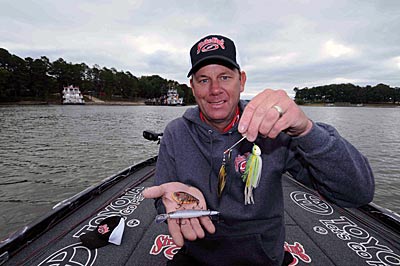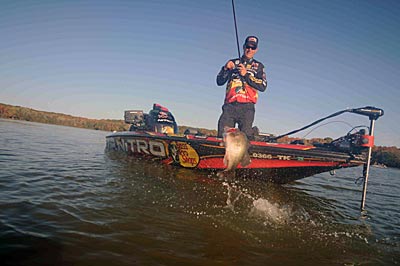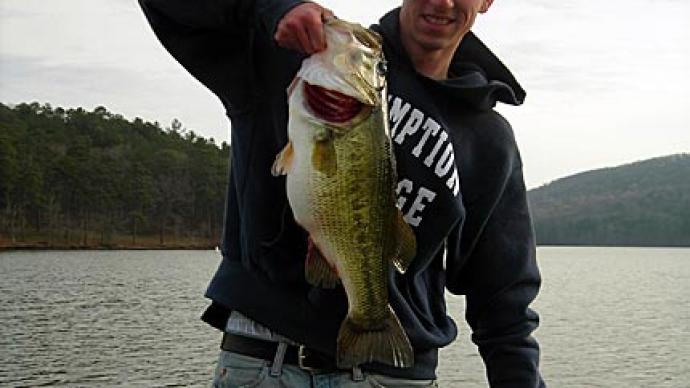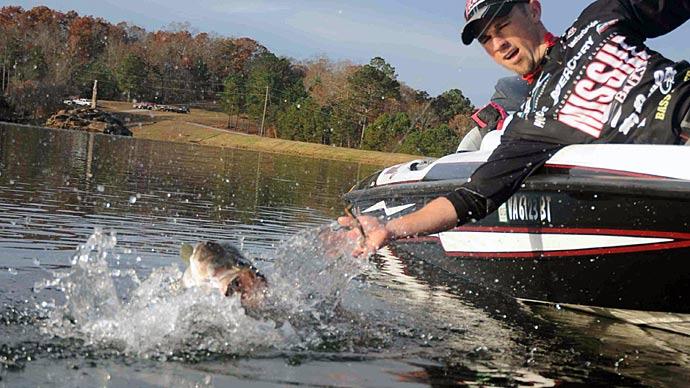
Bass are on the move during the prespawn, so it’s crucial to use a lure that covers water quickly to find these fish.
Whether he is fishing the grass lakes of the south or the rocky reservoirs of the Midwest, bass fishing superstar Kevin VanDam relies on search baits to find prespawn bass transitioning from the deep to the shallows. His lure choices for intercepting prespawn bass en route to the spawning banks depend on water clarity, cover, and depth he will be fishing.
Here is a look at VanDam’s top three search bait picks for prespawn bass.
Suspending Jerkbait
“A jerkbait is my bait of choice when I am faced with a clear-water scenario,” VanDam says. “It’s a very efficient bait that I can parallel edges, whether it is a weedline, a channel swing, or a bluff point, those staging areas where prespawn bass are pulling up and getting ready to move into spawning flats.”
The Major League Fishing star relies on this lure in the spring because he knows it will draw bass from a long distance in clear water and is considered a big bass bait. He typically uses a Strike King Deep Diving KVD Jerkbait in a clear highland impoundment such as Bull Shoals or Table Rock, where he wants the lure to dive deeper when he is fishing over 20 to 30 feet of water. On shallower grass reservoirs such as Guntersville or natural lakes in his home state of Michigan, he relies more on the Strike King KVD Jerkbait that dives to 5 or 6 feet.
His jerkbait color choices are based on water clarity. If the water has a light stain, he opts for brighter colors. He picks natural colors such as Pro Blue or Crystal Shad in crystal clear water.
Water temperature and the stage of prespawn bass determine how VanDam retrieves his jerkbait. He employs a slower retrieve in colder water, toning down his twitching cadence and using longer pauses. “As it gets warmer and closer to the spawn, I am going to pick up the pace with my retrieve, which will allow me to fish a little bit faster,” he says. The key to his retrieve is twitching the lure with slack in the line to create an erratic side-to-side action on the bait. He works the jerkbait on a 6-foot, 10-inch medium-heavy casting rod and a high-speed baitcast reel filled with 10- to 12-pound fluorocarbon line.
Lipless Crankbait
“A lipless is great for covering a lot of flats,” VanDam says. “If I am on a lake with lots of vegetation, it is a go-to during the prespawn. The flat sides on it and the rattle make it well known as being very efficient for catching prespawn bass.” He notes even in lakes without grass, it can be effective when the fish are moving out of the deep water towards the spawning flats because the lure allows him to cover “a ton of water very efficiently,” and it effectively fishes a depth zone from zero to 8 feet.

The Michigan pro favors the Strike King Red-Eyed Shad for his lipless crankbait presentations. He frequently fishes the 1/2-ounce model and the Tungsten 2-Tap version because it is slightly heavier than the original Red Eyed Shad, so he can run it deeper. He also likes the unique sound of the 2-Tap model. If he wants to fish deeper than 8 feet, VanDam switches to the 3/4-ounce Red Eyed Shad.
VanDam notes red is a legendary lipless crankbait color to throw in the spring, but he also likes to try crawfish and bream patterns during the prespawn. If the water is dirty, he will use a chartreuse model. Gold is a favorite color of VanDam’s for slightly stained to clear water.
The Red Eyed Shad is ideal for the pull-and-drop retrieve VanDam employs because the lure has a shimmy action on the fall. During his retrieve, VanDam pulls his rod to the side rather than lifting it straight up, so the lure remains close to the bottom. “It is essential to ensure the bait is down on the bottom,” he says. “If you are reeling it and not hitting anything, you must stop and let the bait fall.”
His lipless crankbait gear consists of a 7-foot crankin rod and a 5.3:1 gear ratio baitcast reel. When fishing shallow flats and grass, VanDam runs his Red Eyed Shad on 17-pound fluorocarbon, but he scales down to 10-pound test when fishing in deeper water.
Spinnerbait
VanDam lists the spinnerbait as an “incredible bait because I can control its depth.”
Lake levels frequently rise in the spring and flood shoreline bushes, so VanDam favors a spinnerbait in this situation to slow roll around the bushes. He can also pitch the blade bait around docks and run it through grass. The lure is also a proven big bass catcher.
The four-time Bassmaster Classic champion relies on a 3/8-ounce spinnerbait with double Colorado blades for targeting shallow flooded cover. He opts for 1/2- or 3/4-ounce models with a Colorado and willowleaf blade combination for fishing transition banks near deep water. When fishing grass in clear water, he slow rolls a double willowleaf spinnerbait but switches to a double Colorado model in dirtier water.
VanDam’s preferred spinnerbait skirt colors for prespawn bass are white, white-and-chartreuse, and shad patterns. He also selects bluegill pattern skirts for fishing in gin clear water. His blade color choices mainly include a silver-and-gold combination, although he will use two silver blades for clear water and gold or white blades for dirty water.
A slow to medium speed retrieve produces the best for VanDam’s spinnerbait tactics. “I slow roll a spinnerbait a lot,” he says. “Even if I am fishing in 2 feet of water, I just use a lighter bait with a double Colorado and keep it closer to the targets longer, but if I am fishing deeper grass, it’s pretty much a slow roll.”
The key to his retrieve is to run the lure slightly above the cover, whether it’s the grass tops or limbs of a laydown log. “It is all about keeping that bait just above the bass’ line of sight or the depth you think they are,” he says. VanDam retrieves his spinnerbait on 20-pound fluorocarbon with a 7-4 heavy action casting rod and a 6.6:1 gear ratio baitcast reel.
BassResource may receive a portion of revenues if you make a purchase using a link above.




